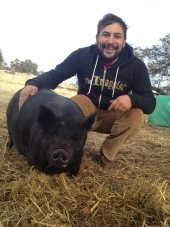That is a good, diverse mix and should grow up some pork for you nicely.
Regarding Expired produce: Personally I have problems with the 'health' of some produce, because of sprays, radiation and/or other modern measures regularly taken. If we don't eat it in my family I don't feed it to the animals that we do eat, but this is just me.....
Because of this I would watch the processed foods. However, if the source doesn't bother you, and your not keeping any of these pigs as breeders then feed around 20% of their feed in the breads on top of a grass ration, in other words feed this at the end of the day. Spent grains are actually better than dry whole grains as the anti-nutrients have been mitigated through the fermentation process.
As for the spent grains - I would recommend you feed them wet if at all possible, again in the 20-25% of total feed amounts. While wet they can go bad quickly so just re-wet before feeding if your storing them.
In my opinion, feeding 'wet' feed as the bulk of the diet is better for non-Ruminant animals when possible. There are many studies on this you can find by doing a simple search. I'll see if I can find my sources and post back if your interested in the science. It's been a while since I've read up on it. I really respect what Walter has been able to achieve with feeding hay to his pigs in the winter, he has a great set up. But I personally did find it fit my feed requirements - your millage may vary. I raise only small breed pigs, and my ground is not covered by snow nor does it freeze, it is in fact a soft mess in the winter due to heavy rains. I'll have to post my experiment last winter with feeding dry hay

Note: different breed of pigs grow and develop differently, so know your breeds and their traits, and your weather and land. It all plays a roll in your animal husbandry.
Shameless plug for dairy animals & home grown feed - having one's own steady source of proteins and vitamins such as found in dairy (goats, sheep or
cattle) is a
sustainable feed model. And easy to maintain by growing small amounts of high quality feed like alfalfa, and some grains and feeding those to one's dairy animal - then feeding some to the other animals plus the milk. It's a sustainable model people have been successfully using for hundreds of years. So if your reading this and you do not have sources for free veggies, spent grains, gallons whey, etc. don't worry remember that most people through out time didn't either


 1
1





























